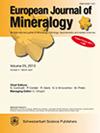Supergene phases from ferruginous duricrusts: non-destructive microsampling and mineralogy prior to (U–Th) ∕ He geochronological analysis
IF 1.7
3区 地球科学
Q2 MINERALOGY
引用次数: 0
Abstract
Abstract. Interpreting the ages of supergene mineralogical phases in laterite is complex because they consist of polycrystalline mixtures of different phases at the microscopic scale that could be crystalized at different epochs. Among the geochronometers, the (U-Th)/He method on hematite and goethite is more often used, but ages can be difficult to interpret due to phases mixing. To resolve this issue, this study proposes a methodology for performing detailed mineralogical analysis of hematite and goethite single grains prior to their dating using the (U-Th)/He method. Strictly non-destructive mineralogy of single grains is not achievable by classical tools, such as conventional powder XRD (X-ray diffraction; requiring at least some milligrams of powder) or SEM (scanning electron microscopy; that can contaminate the grain by coating or fixing). Therefore, we performed X-ray diffraction patterns of single grains using high-flux X-ray beams from both a rotating anode (XRD_rotat) laboratory diffractometer and a synchrotron beamline (XRD_synch) and compared the results in order to design a method based on XRD_rotat only. For this purpose, two samples from the pisolitic facies of a Brazilian ferruginous duricrust (Alto Paranaíba region, Minas Gerais State, Brazil) were chosen because they presented a usual heterogeneity. Rietveld refinements of the XRD patterns obtained from both XRD_rotat and XRD_synch yielded similar results for the weight percentage ratio of the main phases and mean coherent domain sizes and less similar results for Al substitution rates, thus validating the XRD_rotat approach. No beam damage was observed when increasing X-ray exposure time, neither on XRD patterns nor on (U-Th)/He ages. Hence, sub-millimeter, undisturbed grains can be used to analyze the mineralogy of ferruginous duricrusts by XRD_rotat with a short exposure, and the same grains can subsequently be dated by (U-Th)/He geochronology analysis. The (U-Th)/He dating of pisolitic core and cortex grains also provided meaningful ages: they revealed two evolution phases of the ferruginous duricrust, which occurred at or before the Oligocene for the pisolitic core and middle Miocene for the pisolitic cortex, agreeing with the previous model for the development of pisolites. The mineralogy of single grains selected for dating is helpful for discussing the crystallization ages, and the high-flux XRD approach may be applied to other supergene mineral parageneses used for absolute dating.含铁硬壳的浅生相:(U–Th)之前的无损显微取样和矿物学 ∕ 何地质年代分析
摘要解释表生矿物相嵌岩的年龄很复杂,因为它们由微观尺度上不同相的多晶混合物组成,可以在不同时期结晶。在地质年代计中,赤铁矿和针铁矿的(U-Th)/He法更常用,但由于相混合,很难解释年龄。为了解决这一问题,本研究提出了在使用(U-Th)/He方法测年前对赤铁矿和针铁矿单颗粒进行详细矿物学分析的紫外光度法。传统工具无法实现单颗粒的严格无损矿物学,如传统的粉末XRD(X射线衍射;需要至少几毫克粉末)或SEM(扫描电子显微镜;可能通过涂层或固定污染颗粒)。因此,我们使用来自旋转阳极(XRD_rotate)实验室衍射仪和同步加速器光束线(XRD_synch)的高通量X射线束对单个晶粒进行了X射线衍射图,并对结果进行了比较,以设计仅基于XRD_rotat的方法。为此,选择了两个来自巴西含铁硬壳(巴西米纳斯吉拉斯州上巴拉那地区)的同生岩相样品,因为它们具有明显的不均匀性。从XRD_rotat和XRD_synch获得的XRD图谱的Rietveld精细化对主相的重量百分比比和平均相干畴尺寸产生了相似的结果,而对Al取代率产生了不太相似的结果。因此验证了XRD_rotate方法。无论是在XRD图谱上还是在(U-Th)/He年龄上,当增加X射线曝光时间时都没有观察到束损伤。因此,亚毫米级的未扰动颗粒可用于通过XRD_rotat和ashort暴露分析含铁榴壳的矿物学,随后可通过(U-Th)/He地质年代分析确定相同颗粒的年代。豆粒和皮质的(U-Th)/He定年也提供了有意义的年龄:它们揭示了含铁硬壳的两个演化阶段,豆粒发生在渐新世或渐新世之前,豆粒出现在中新世中期,与先前的豆粒发育模型一致。选择用于定年的单颗粒的矿物学有助于讨论结晶年龄,高通量XRD方法可以应用于其他用于绝对定年的超成因矿物副晶。
本文章由计算机程序翻译,如有差异,请以英文原文为准。
求助全文
约1分钟内获得全文
求助全文
来源期刊
CiteScore
2.80
自引率
9.50%
发文量
40
审稿时长
6-12 weeks
期刊介绍:
EJM was founded to reach a large audience on an international scale and also for achieving closer cooperation of European countries in the publication of scientific results. The founding societies have set themselves the task of publishing a journal of the highest standard open to all scientists performing mineralogical research in the widest sense of the term, all over the world. Contributions will therefore be published primarily in English.
EJM publishes original papers, review articles and letters dealing with the mineralogical sciences s.l., primarily mineralogy, petrology, geochemistry, crystallography and ore deposits, but also biomineralogy, environmental, applied and technical mineralogy. Nevertheless, papers in any related field, including cultural heritage, will be considered.

 求助内容:
求助内容: 应助结果提醒方式:
应助结果提醒方式:


